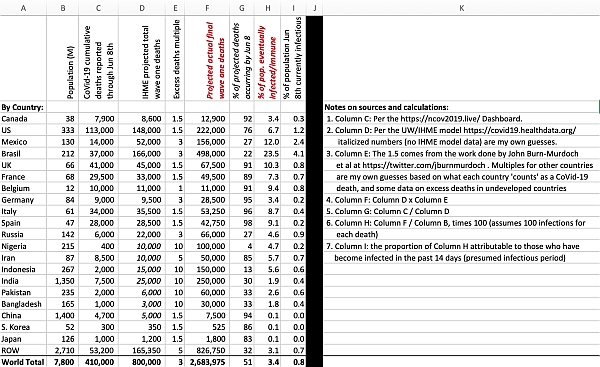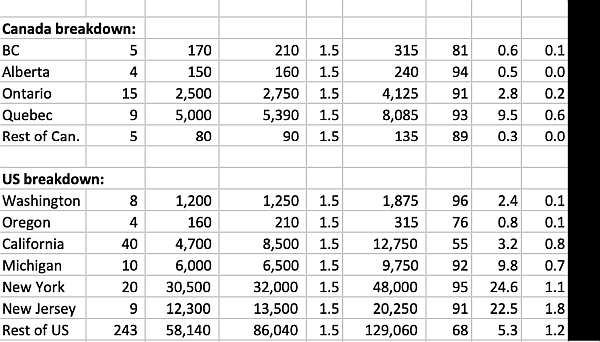This article was posted by CrystalWind.ca.
CoVid-19 Update #8: By the Numbers
- Details
- Written by Dave Pollard
The numbers above are my own second-guessing of published data on CoVid-19 as at June 8th, 2020. For reasons explained below, they may be wildly inaccurate, but they’re my best guesses at this point, based on the sources cited.
This is my eighth and likely final update on what we know and don’t know about the first wave of the CoVid-19 pandemic. Those of us who’ve been following the numbers are getting increasingly disenchanted with the quality of data reporting, and it’s looking as if our wild guesses on how it’s proceeding will only get wilder as the data gets more and more suspect.
Spain, for example, presumably eager to jump-start its collapsed tourist industry, has essentially just stopped reporting new deaths. So has Brasil, a little more blatantly. And even in countries that have tried hard to report accurate data, much of what’s happening now is what in the wooly world of accounting is called “prior period adjustments” — jurisdictions reporting higher cumulative death totals but asserting that almost all the recent deaths actually happened a week or two earlier so there are almost no “new” deaths to report. Of course, given delays in reporting, this seemingly good news will give rise to further restatements a week or two hence, when today’s deaths are likewise revised sharply upwards. This has definitely “smoothed” some of the numbers for past months, but it dramatically understates some of the actual daily death totals for the most recent days, giving unwitting cover to those proclaiming that the risk has passed and that economies should be fully reopened.
Here’s some of what does seem to be true, however:
- The mortality rate for CoVid-19 Wave One continues to look to be around 1.0%, based on retroactive data on excess deaths and on serology tests that estimate the proportion of populations that (symptoms or no) have been infected with the virus. The chart above, as of today, takes a stab at what the final actual Wave One death counts will be in various jurisdictions. Sources of the data for each column are shown, and as you can see some of them are pretty wild guesses, but it’s doubtful with the current obfuscation that we’ll end up with anything much more accurate in retrospect.
- The actual likely deaths from the virus are continuing to average about 50% more than official reported figures even in the most diligent jurisdictions, for several understandable reasons I’ve mentioned in earlier posts. In countries with less advanced monitoring and reporting, it’s likely, as some reports have suggested, that actual death tolls could be as much as ten times official reports. The worst offenders are not necessarily the usual suspects however. There is some compelling evidence that China actually did, with its draconian measures, essentially halt spread of the virus so that only 0.1% of its population was infected. And while Russia is likely understating its numbers, its low male life expectancy means that less of its population is in the most vulnerable age groups; and Russians travel less than Western Europeans so we would expect less exposure to the virus especially outside the big wealthy cities. India’s data is a big question mark as well, with its young population less vulnerable to the virus, low reliance on the hospital system, and few funerals. And Brasil is anyone’s guess: Latin America (and Latino Americans in the US) seem especially vulnerable to the virus.
- Probably about 3% of the world’s population will be infected by Wave One of the virus by this summer; but that number hides some huge variations both between and within countries. It’s likely that over 20% of people in some big cities will have been infected, more than twice the infection rates for the rest of the country. (Highest proportion is 57% in Bergamo, Italy’s hardest-hit city.) And in some places in these same countries infection rates are less than 0.5%; and less than 0.1% — under one person in a thousand — is likely still infectious. Therein lie the hazards of early relaxation of restrictions. Nowhere is the number who’ve been infected (and presumably are now immune) anywhere near “herd immunity” levels.
According to a report today from the WHO, research now suggests “it seems to be very rare that an asymptomatic [infected] person actually transmits [CoVid-19] onward to a secondary individual”.[EDIT June 9th noon: the WHO just walked back this assertion, saying it was inaccurate to say this was “very rare”; these guys just can’t seem to get their act together. Here’s a taste of the staggering damage this reckless WHO statement has done in just a few hours].That means almost all transmission is from people visibly suffering from symptoms of the disease, which reinforces other evidence that this disease is less infectious than we thought, and more deadly when it is transmitted than we thought. And reinforces that, alas, the vast majority of us have zero immunity if the relaxation of restrictions leads to new spikes in cases, and to the next wave.- Anthony Fauci reported today that, even when a vaccine is developed and safely introduced, “it likely isn’t going to be a long duration of immunity.” The level of rigour needed to vaccinate everyone not just once but regularly is going to be an ongoing challenge. Some coronavirus research has suggested we may all need to be inoculated more often than once a year.
- Two new as-yet-not-peer-reviewed articles pre-published today in the journal Nature say it’s likely that (imposed and voluntary) restrictions on contact have already reduced the number of cases by more than half a billion in just six nations studied, including 285 million in China and 60 million in the US. With a 1% mortality rate that’s five million lives saved. The second study says three million lives have been saved in a dozen European countries (an 82% overall reduction in cases and deaths), equating to a reduction of 300 million infections in those countries. At least eight million lives already saved in fewer than 20 countries studied; probably worth the social and economic sacrifice, no?
- A group of 511 epidemiologists surveyed about their personal plans for the next year said the following activities are off the table for them until at least next year:
- attending weddings, funerals, church services, sporting events, concerts or plays
- going out with people they don’t know well
- hugging and handshaking
- not wearing a mask when not social distancing
- the same group will mostly also not do the following at least until the fall: dinner parties, picnics, camping, day care, play dates, buses, subways, airplanes, gyms, dine-in restaurants, shared office spaces, visiting elderly relatives, visiting friends in their homes
- Those on the west coast of North America who were feeling a bit smug about their low infection rates relative to the rest of their countries might be chagrined to know that it appears most of the west coast cases are genetically closer to the European variant of the virus than the Chinese variant. That suggests that despite some very early first reported cases in California, Washington and British Columbia, the virus probably made its way from east to west, so west coasters actually had a few extra days to shut down and social distance relative to hard-hit New Yorkers and Québecois, rather than the other way around. More possible evidence for just how effective the Asian actions and preparedness were compared to the rest of the world’s.
- And though it probably needn’t be repeated, it’s still absolutely true that we don’t know how CoVid-19 kills us. And we also don’t have any idea why some countries with big crowded cities (Sri Lanka, Lebanon), lots of travel, lots of old people (Japan), lots of poverty (Haiti), and few restrictions (Cambodia) have largely been untouched, while others that have locked down early (Peru), whose people travel relatively little (Dominican Rep.), have low poverty levels (Belgium), have young populations (Ecuador), and are less densely populated (Bolivia), have been hammered. It has to be more than luck, and perhaps the next wave will be an equalizer, but I’m not so sure: there must be a reason.
I got passionate about this when I worked with a group of epidemiologists for a while after the SARS virus emerged. I realized then (and wrote about) how great the danger was and how unprepared we were for it. I wish I’d been wrong. I still think this is just a test run; it could have been, and eventually will be, much much worse. Ready or not.
© CrystalWind.ca 2024. All content (articles, imagery, fair use) & design protected. Written permission required for copying. All rights reserved.
Join the Conversation Now! Comment Below! ![]()

Spirit Animal Totem Of The Day!
Crystal Of The Day!
Latest Articles
The Crystal Wind Oracle
Myth & Magic Card Deck!
Details Here!
NEW Expanded
Printed & Boxed!
Now with 58 cards!
CrystalWind.ca is free to use because of
donations from people like you.
Donate Now »

Unlock Your Light: Join Lightworkers Worldwide on CrystalWind.ca!
Follow Us!
Who is Online Now
We have 27752 guests and no members online
Featured This Month
The Time of No Time: Beltane!
Around the medicine wheel of life we go, from season to season (solstice to ... Read more
The Seven Chakras and their Meanings
If you could imagine chakras as circles of energy, flowing all the way throu... Read more
Cartomancy - Fortune Telling Using Playing C…
Cartomancy is the act of divining using cards. Divining means to find out by... Read more
Frogs Return Moon
Beaver – Chrysocolla - Blue Camas – Blue April 20 – May 20 The Frogs Retur... Read more
Bright Beltane Blessings!
The wheel turns to Beltane, also known as Mayday, marking the beginning of S... Read more
Sun in Taurus
Sun in Taurus April 21 through May 21 An Overview of Sun Sign Characteristi... Read more
The Crystal Wind Oracle Card Deck
The Crystal Wind Oracle™ The Crystal Wind Oracle Myth & Magic Card D... Read more
Taurus Mythology
The Taurus Myth The Taurus myth is most often interpreted as the story of Z... Read more













































